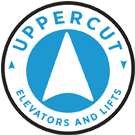If you or a loved one has trouble with stairs, especially outdoor ones, you’re not alone. For many people with mobility challenges, even a few steps can turn into a daily obstacle. That’s where residential porch lifts come in. These practical, space-saving devices offer a safe and easy way to move between ground level and raised areas like porches, decks, or elevated home entrances.
Also known as vertical platform lifts (VPLs), porch lifts are a simple yet powerful solution that restores independence and confidence at home. Whether you’re helping a family member age in place or improving accessibility for a public building, these lifts make everyday life more manageable.
At Uppercut Elevators and Lifts, we specialize in providing residential lifts designed specifically for Canadian homes and weather. So, what is a porch lift, and how can it help improve accessibility in your space?
What Is a Porch Lift?
A porch lift is a type of residential lift that works much like an open elevator. It’s specifically built for outdoor use and is most commonly installed next to stairways leading to a home’s front or back entrance. Unlike ramps, porch lifts take up minimal space and are ideal for users of wheelchairs, walkers, or scooters.
These lifts operate using a motorized platform that travels vertically to bridge different height levels. Most porch lifts accommodate heights from a few inches to six feet or more, depending on the model.
Why We Recommend the Bruno VPL for Residential Outdoor Porch Lifts
Our preferred lift for exterior installations is the Bruno VPL (vertical platform lift). We recommend this wheelchair lift for residential applications for the following reasons:
Drive mechanism – The Bruno VPL utilizes a reliable ACME screw drive. Unlike hydraulic drives, there is no hydraulic fluid to thicken when the temperature gets cold.
Finish – Some outdoor porch lifts are simply painted, but all Bruno’s are finished with a durable powder coating that ensures the finish will stand up to the elements.
Outdoor package – The Bruno VPL requires just 8 amps under full load, making it ideal for a standard 15-amp breaker. Many other lifts draw up to 13 amps, which can cause blown fuses in cold weather. Bruno’s use of aviation grease and an all-weather wiring package helps ensure reliable performance even in extreme conditions.
Choosing a Provider
When choosing a porch lift, it is important to do a detailed comparison to ensure that the specifications of each product and company match. Areas where discrepancies can occur include:
Standard platform size – You should note that not all manufacturers make a standard platform that will accommodate a larger wheelchair or scooter. This is sometimes a costly upgrade, so it needs to be discussed up front.
Finish – Some lifts are painted while others come with a durable powder-coated finish. Remember to ask about the costs associated with powder coating your lift.
Capacity – 750lbs seems to be the industry standard, but there are still some 550lb capacity lifts on the market.
Cold weather operation – Some porch lifts require the addition of an outdoor package. If your lift is exposed to the elements, make sure it has this provision. Another key element is the number of amps it draws under full load. I would suggest a device that draws under 10 amps to ensure your lift operates in cold temperatures.
Safety features – Ask about the lift’s safety record. Does it have an underpan sensor, solid side walls, a fall arrest system, and an easy-to-access manual lowering device?
Where you buy – While it’s hard to quantify at the time of purchase, the quality of service and support should factor into your decision. Look for a company like Uppercut Elevators and Lifts that communicates promptly, offers in-person consultations, provides detailed quotes, and has the team and resources to support your porch lift after installation.
Trusted Residential Lifts In Alberta
If you’re considering a porch lift for your home or public building, our team at Uppercut Elevators and Lifts can help you find the right solution. We supply and install reliable, CSA-compliant residential lifts built for Canadian conditions.
Contact us to learn more about available models and request a quote. We’re here to make accessibility easy, one lift at a time.
